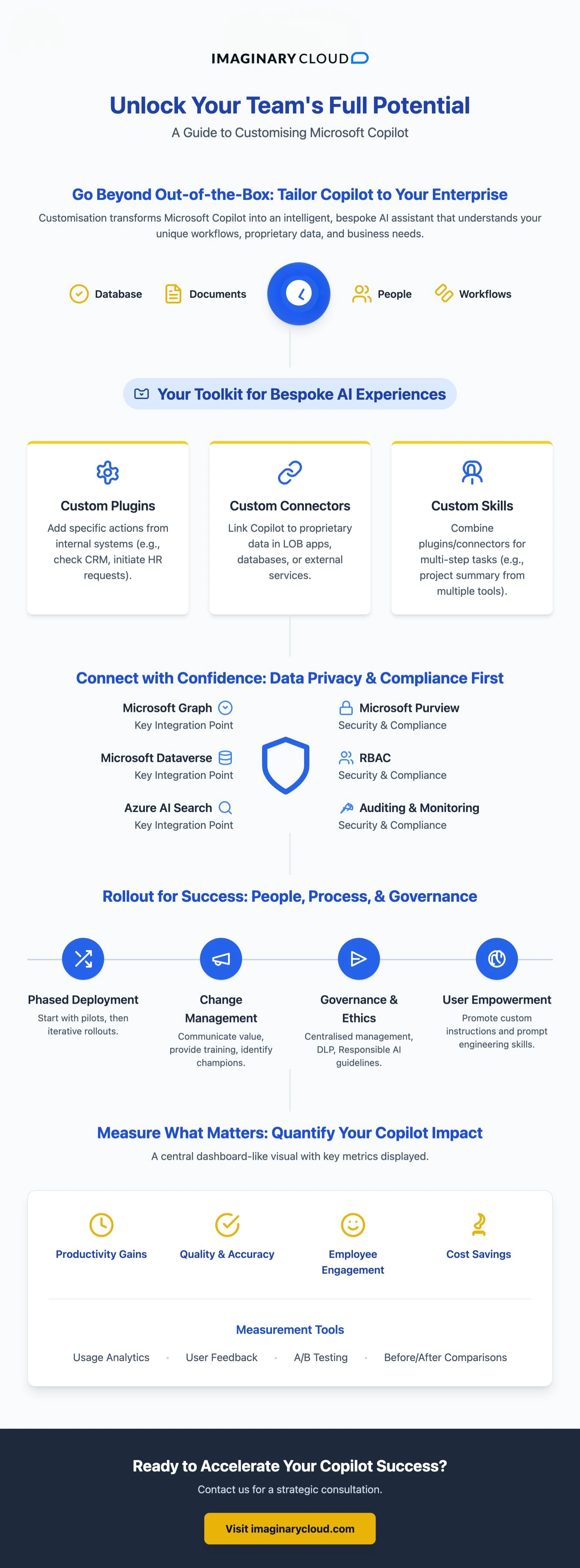contact us


Microsoft Copilot customisation allows organisations to tailor this AI assistant to specific internal workflows, proprietary data, and unique business needs, moving beyond out-of-the-box functionality.
This guide will walk you through leveraging Copilot Studio, securing integrations, ensuring successful adoption, and measuring the tangible value for your enterprise.
Microsoft Copilot Studio is a low-code platform designed to extend and customise Microsoft Copilot for Microsoft 365, enabling businesses to create bespoke AI experiences. It allows organisations to connect Copilot to custom data sources, build unique plugins, and define specific skills that align with their operational needs. This goes beyond standard Copilot functionality, giving teams a truly tailored AI assistant.
To truly empower your internal teams, Copilot needs to understand and interact with your unique business processes and data. Microsoft Copilot Studio makes this possible by allowing you to build:
By building these components, you transform Copilot into an expert assistant for tasks unique to your organisation.
Beyond simply accessing data, Copilot Studio lets you refine how Copilot interacts with your users. You can:
Key Takeaway
Microsoft Copilot Studio is the essential tool for transforming standard Copilot into a highly customised, intelligent assistant deeply integrated with your unique business processes and data, enabling bespoke plugins, connectors, and conversational flows.
Secure integration is paramount when extending Microsoft Copilot with enterprise data. It's about connecting responsibly, ensuring data privacy, compliance, and controlled access.
Microsoft Copilot's power comes from its ability to access and synthesise vast amounts of information. For customisation, you’ll likely need to integrate your organisation's unique data:
To manage the underlying infrastructure for these integrations, especially when dealing with large datasets and complex AI services, understanding your cloud computing services is vital for robust and scalable solutions.
Your organisation relies on a multitude of specialised applications. Copilot can connect to these through various methods:
Data security and privacy are non-negotiable. When integrating data with Copilot, focus on:
Key Takeaway
Securely integrating Copilot involves leveraging Microsoft Graph, Dataverse, and Azure AI Search for proprietary data, connecting via APIs and connectors for LOB applications, and strictly enforcing data privacy, compliance, and access controls through tools like Microsoft Purview.

Deploying Microsoft Copilot effectively isn't just a technical task; it's an organisational transformation. Success hinges on strategic planning, robust governance, and proactive change management.
A "big bang" rollout of Copilot can be overwhelming. A phased approach is usually more effective:
Technology adoption is often more about people than features. Effective change management is crucial for Copilot's success:
Successfully navigating this level of technological integration often ties into broader digital transformation guides, where change management is a central pillar. According to research from leading firms such as Gartner, effective change management is often cited as a crucial factor in the success of new technology implementations.
Strong governance ensures Copilot is used responsibly and effectively:
The effectiveness of Copilot largely depends on how users interact with it:
Key Takeaway
Successful Copilot deployment requires a phased strategy, including pilot programmes, robust change management that focuses on communication and training, strict administrative controls for governance and ethical AI use, and empowering users with prompt engineering skills and custom instructions.
Quantifying the return on investment (ROI) for AI tools like Copilot is essential for securing budget, justifying implementation, and demonstrating long-term value. It moves beyond anecdotal evidence to concrete business impact.
Before deploying Copilot, establish clear KPIs that align with your business objectives. These might include:
Once KPIs are defined, you need systems to measure them:
Copilot isn't a static solution. Your strategy should account for its ongoing evolution:
Key Takeaway
Demonstrating Copilot's value requires defining clear, measurable KPIs aligned with business goals, using a blend of usage analytics and user feedback for quantification, and committing to continuous improvement and strategic adaptation for long-term ROI.
Now that you understand the depth of Copilot customisation, visualise the complete journey to maximum team productivity with this detailed infographic:

Customising Microsoft Copilot for internal teams is a strategic imperative for organisations aiming to unlock significant productivity gains and foster innovation. By leveraging Copilot Studio, integrating securely with proprietary data, and implementing robust deployment and adoption strategies, businesses can tailor this powerful AI assistant to their unique operational DNA.
The tangible benefits, from time savings to increased employee engagement and substantial cost reductions, solidify Copilot's role as a transformative tool in the modern enterprise.
Ready to Accelerate Your Copilot Success? Schedule your consultation and build a roadmap for a high-impact deployment.
The main benefit of customising Microsoft Copilot is tailoring its capabilities to your specific internal workflows and proprietary data. This allows it to perform tasks and provide insights directly relevant to your business, significantly boosting productivity and efficiency for your teams, and ultimately demonstrating tangible ROI.
Ensuring data security with Copilot involves integrating it securely with your data sources (e.g., via Microsoft Graph, Dataverse), utilising robust administrative controls like Microsoft Purview for compliance, and enforcing role-based access controls (RBAC) so Copilot only accesses data the user is authorised to see.
Microsoft Copilot Studio is a low-code platform that allows you to extend and customise Microsoft Copilot for Microsoft 365. It's used to build custom plugins, connectors, and skills that integrate with your unique business applications and data, creating tailored conversational AI experiences.
Measuring Copilot's ROI involves defining clear KPIs such as time saved per task, reduction in administrative burden, and improvements in data accuracy. You can quantify these through usage analytics, direct user feedback, A/B testing, and before-and-after comparisons with established baselines, often leading to substantial cost savings and productivity gains.


Alexandra Mendes is a Senior Growth Specialist at Imaginary Cloud with 3+ years of experience writing about software development, AI, and digital transformation. After completing a frontend development course, Alexandra picked up some hands-on coding skills and now works closely with technical teams. Passionate about how new technologies shape business and society, Alexandra enjoys turning complex topics into clear, helpful content for decision-makers.
People who read this post, also found these interesting: